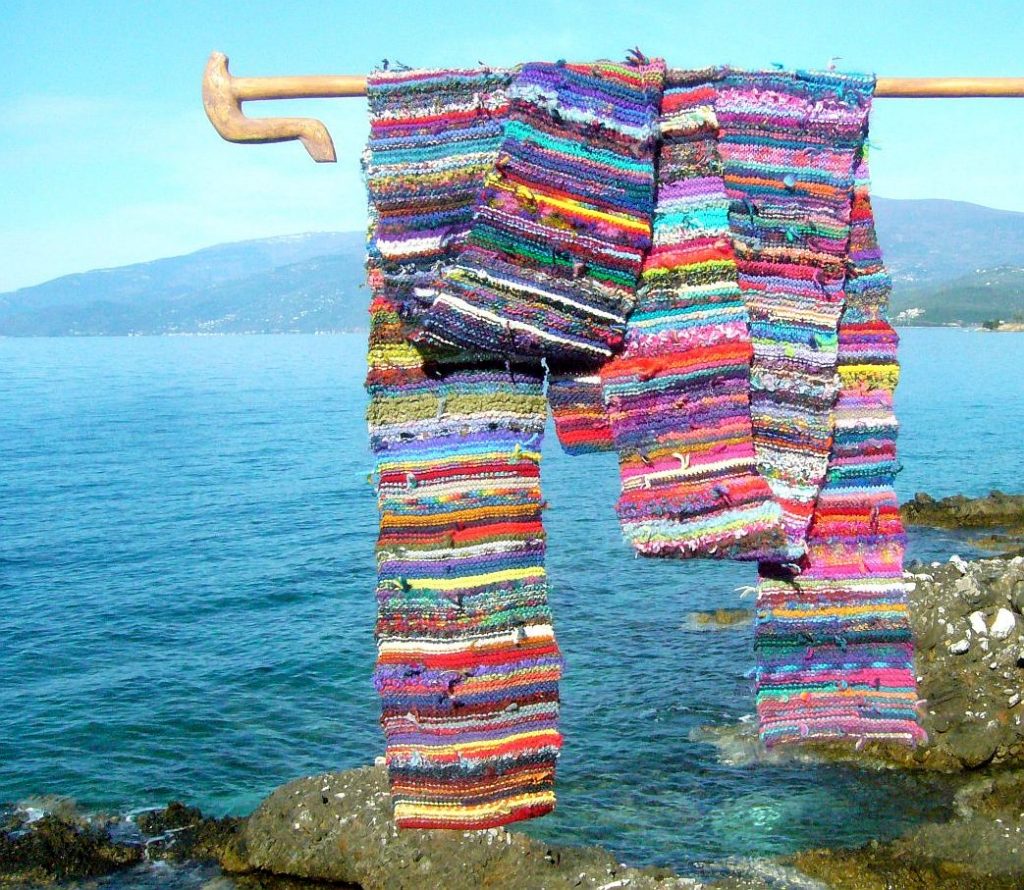
Several years ago my husband had to undergo surgery, and I wanted to have something for him to be a sort of comfort. A blanket came to mind. It needed to be something bright, something cheerful. Different. Happy. And so the idea of the Happy Blanket was born. He loved it, and so did everybody else. I’ve made many since then, and happily given them all away. There’s always one on my needles.
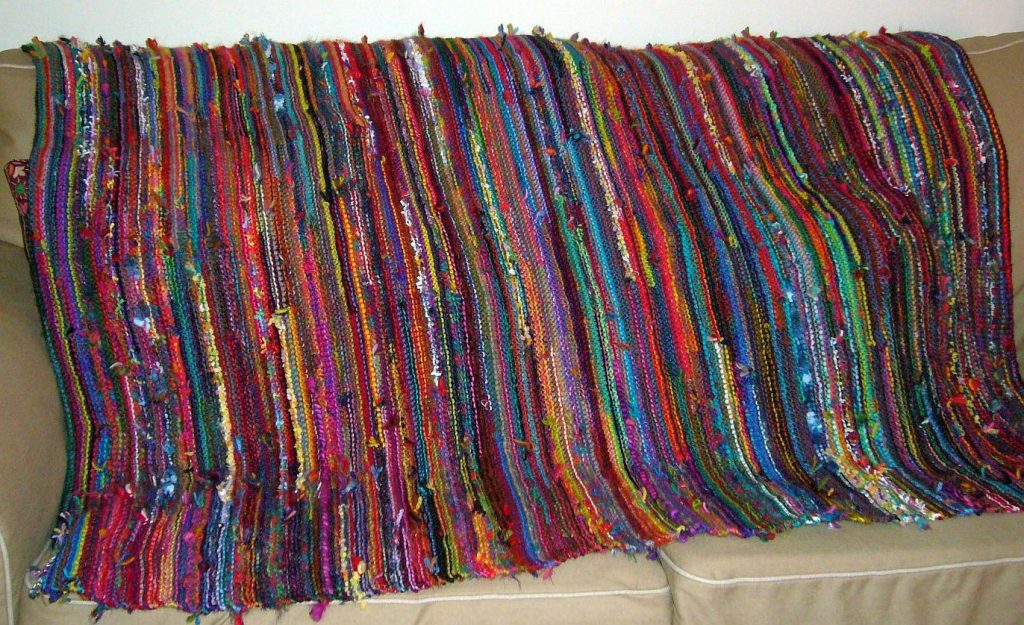

I decided not to overthink the blanket. The idea came from Magic Ball Knitting which I rather enjoy, but I’d not until then made anything as large as a blanket or an afghan using this technique.
There’s something joyful about a colorful knitted piece. At least it is to me, but then I do really enjoy bright colors. And the fact that this is such easy knitting makes me all the more happy. My Happy Knitting pieces are not pretentious, they’re not sophisticated, and yet I’m greatly surprised at people’s reaction to them.
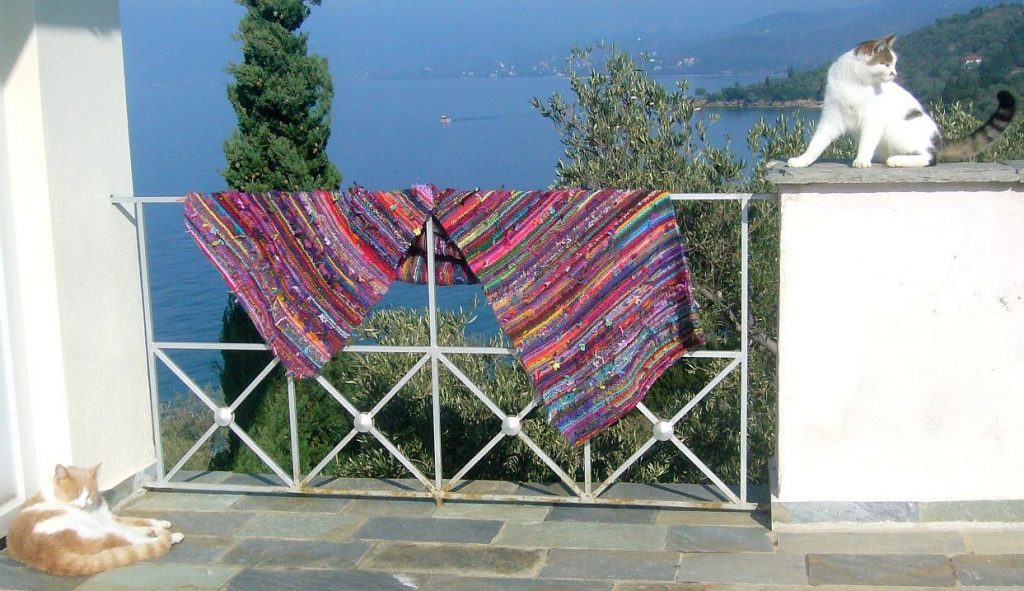
Exuberant shawls, wraps and scarves began to spring to life as fast as I could wind sunny little balls of textured color. And that’s the point of my Happy Knitting – I love the knots. I make no attempt to hide them. This is carefree knitting at its best. A dropped stitch? It’s not going to get very far, though of course it’s good to keep a count of your stitches.
Making the balls is all part of the fun. I certainly do use up leftover bits – happy memories of knitting projects – but I cut lengths from my yarn stash. This is not exactly a small one, due in part to my tendency to collect just one ball of yarn where I can as a travel souvenir. My Happy Knitting yarn balls are full of stories of where and when and how the yarn was acquired, and of fond thoughts of the people connected to them.
This is my Grab ‘n’ Go knitting – ideal for driving in the car or situations where I can’t concentrate too much. It’s trouble free, uncomplicated, and the results are most satisfying.
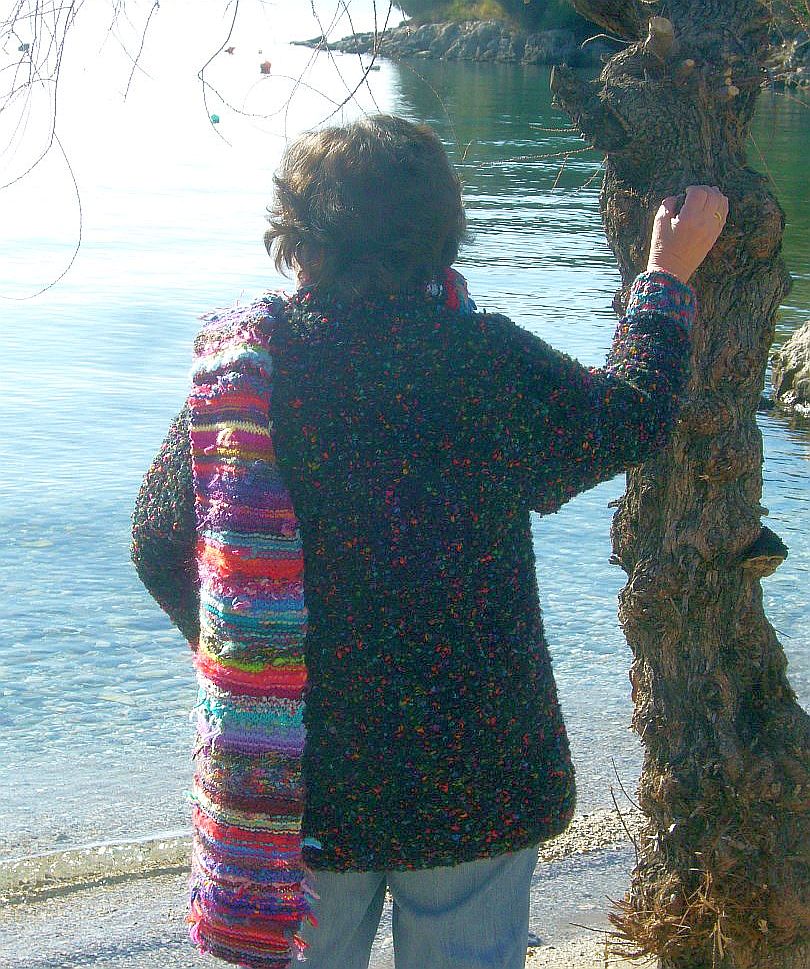
A Happy Scarf cheers me up instantly on the dullest day – and the winter seems to have made a point of being as grayly dreary as possible this year. It’s also a great conversation starter as I’m often asked where I got it. A few brave souls have even been given a brief tutorial!
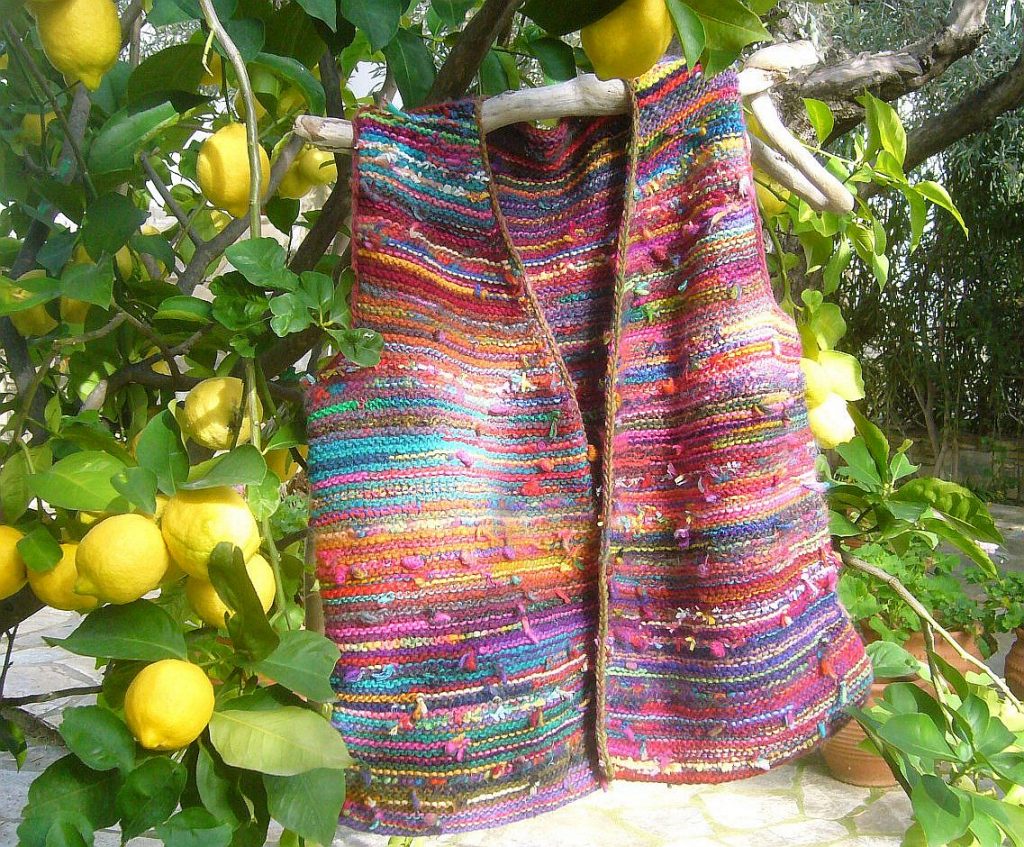
My Happy Vest has proved very useful – it goes with anything.>
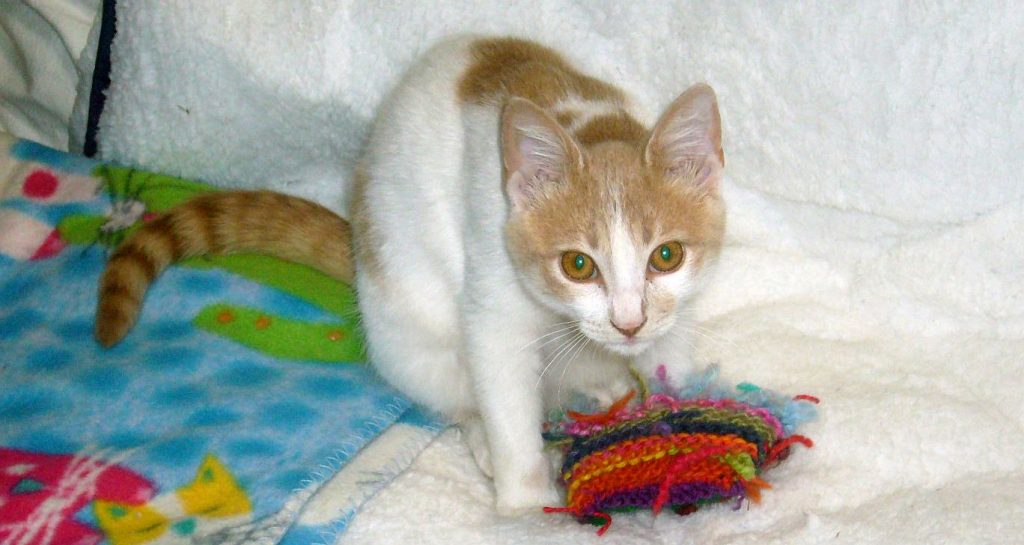
The cats have been as helpful as always while we attempted to photograph a few items here on the Pelion Peninsula. The newest rescue, Haig, is rather taken with his Happy Cat Toy, and slowly learning to trust us.
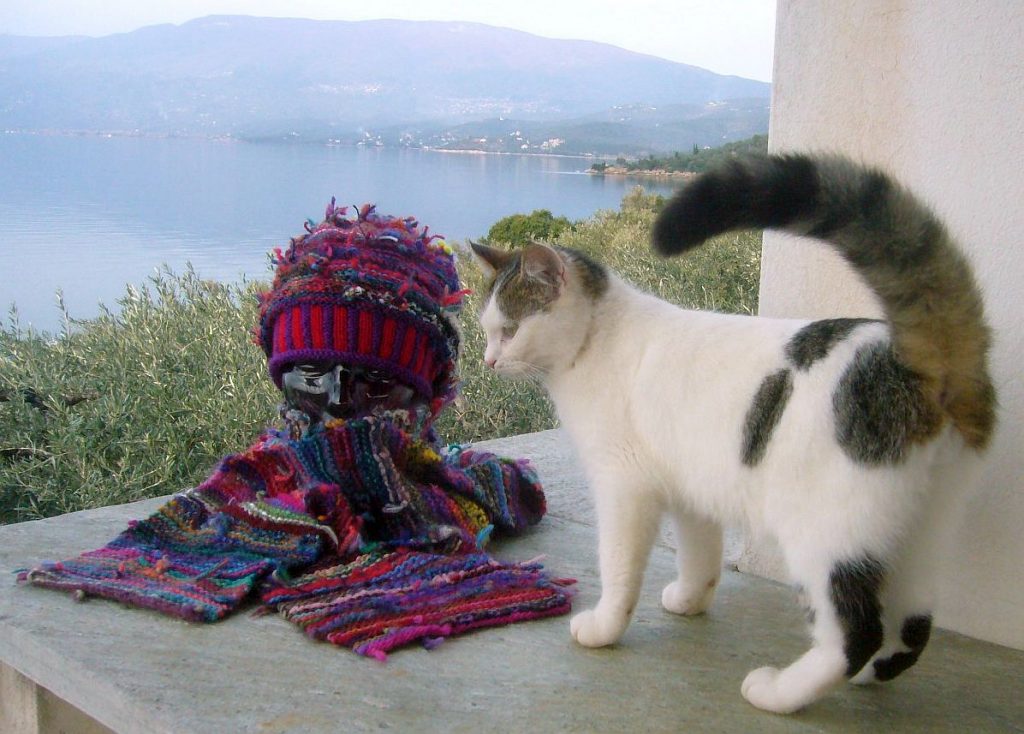
Jason did his quiet duty as always, quite unperturbed by Olly’s curiosity.

Raki – not to be confused with Olly – is slowing down quite a bit now, and prefers to spend his time snuggled in a Happy Shawl. I reckon he’s got the right idea.
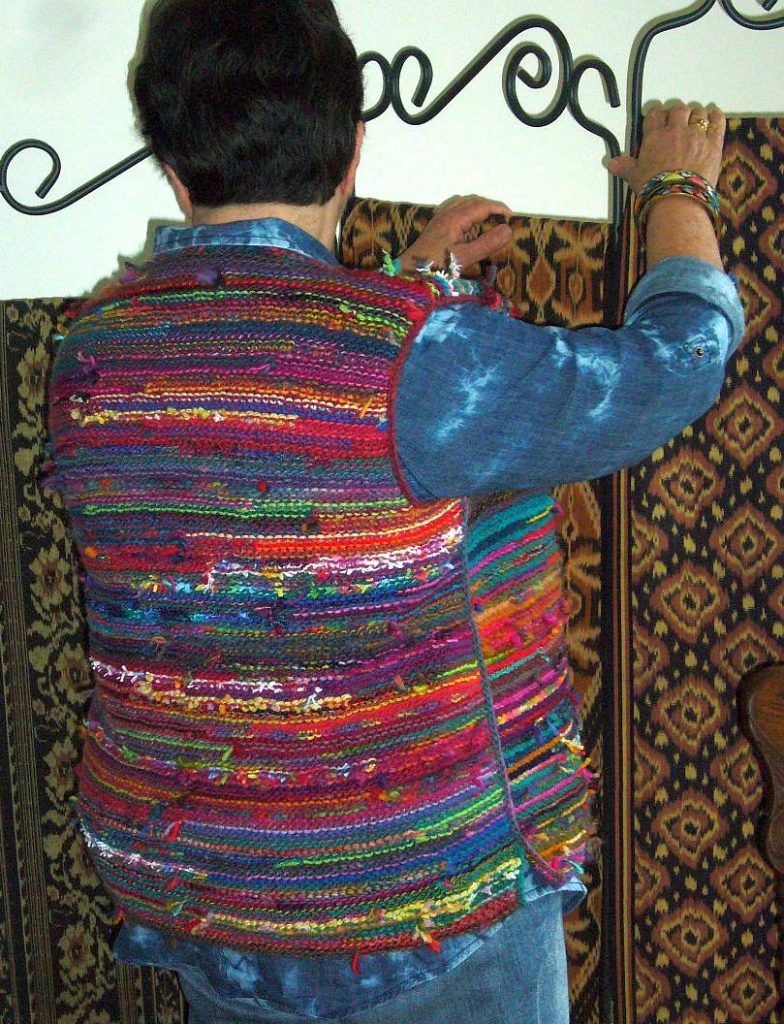
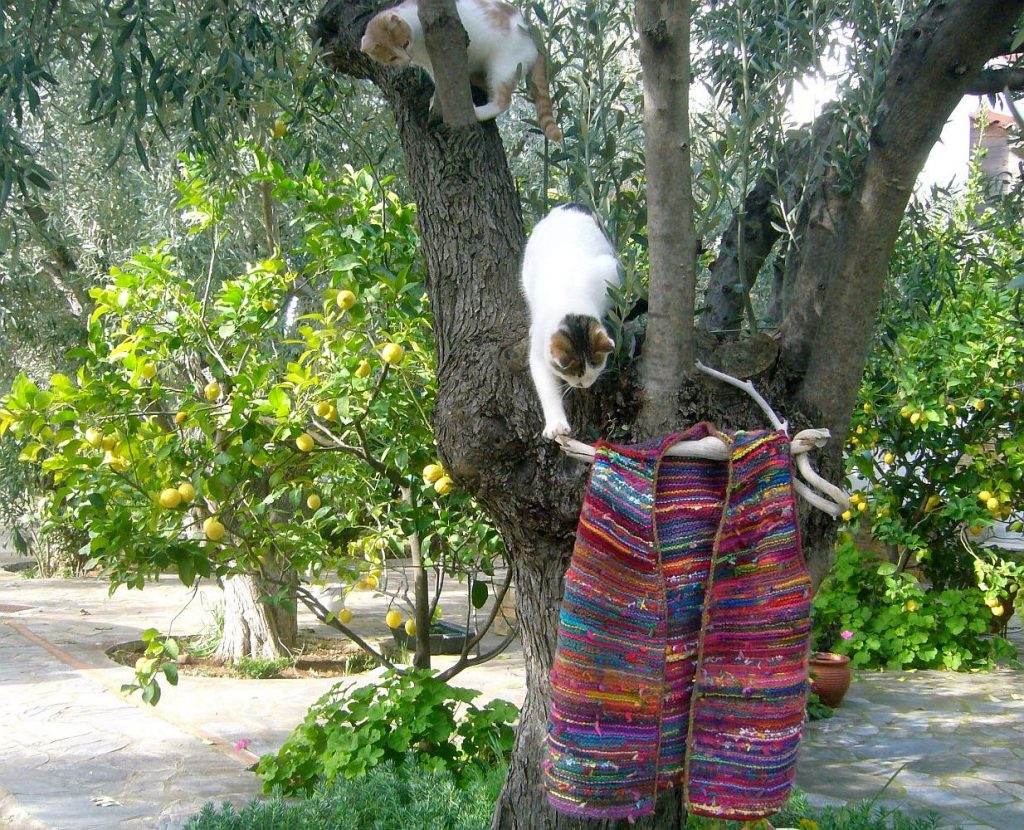
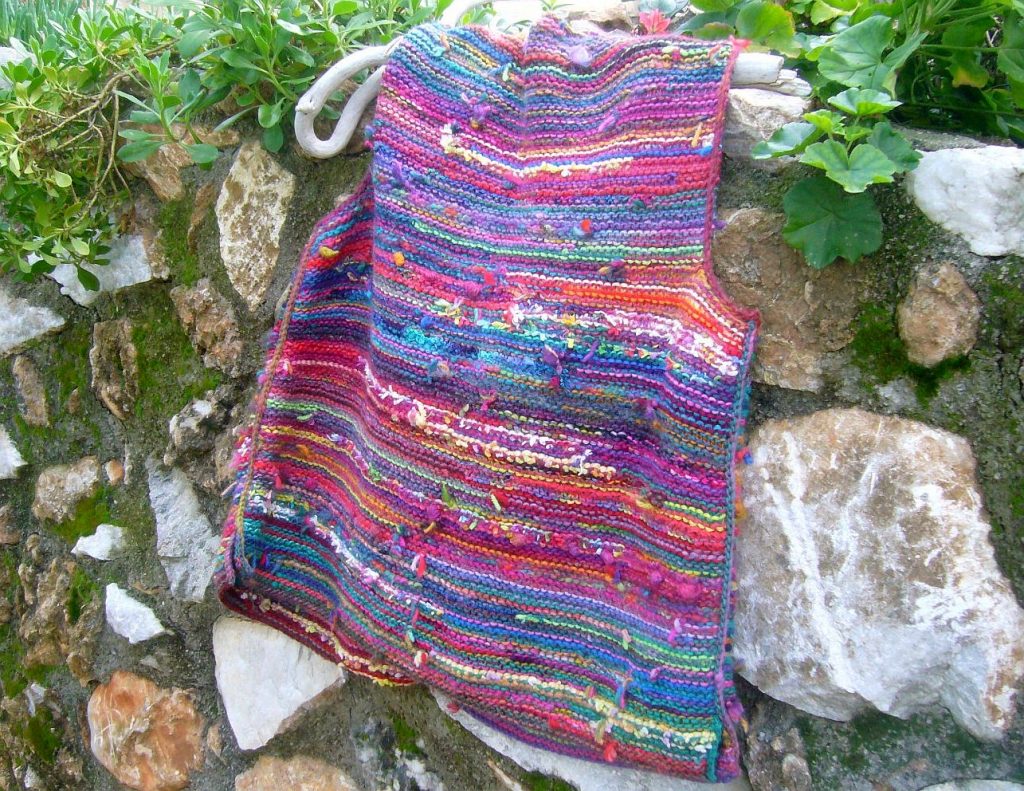

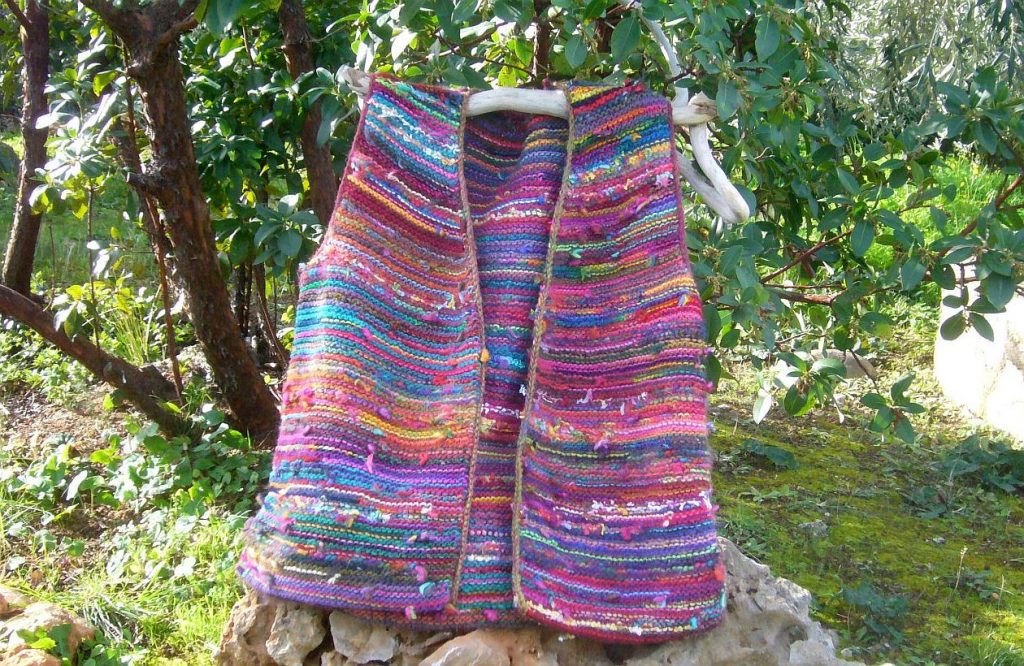

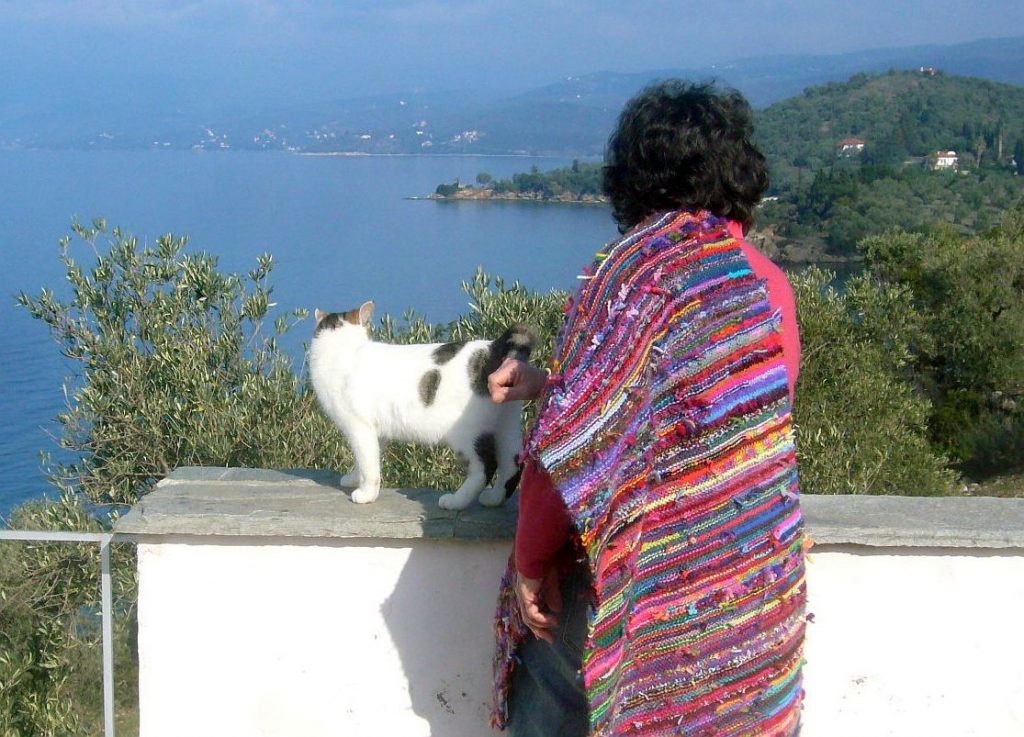

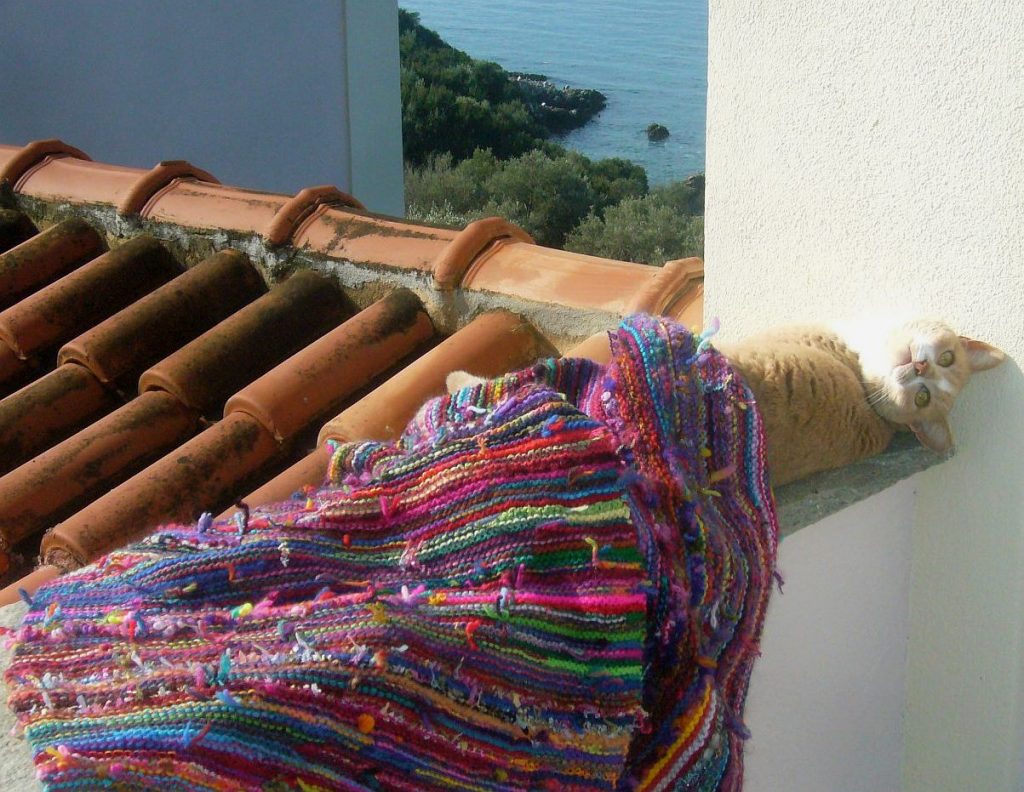
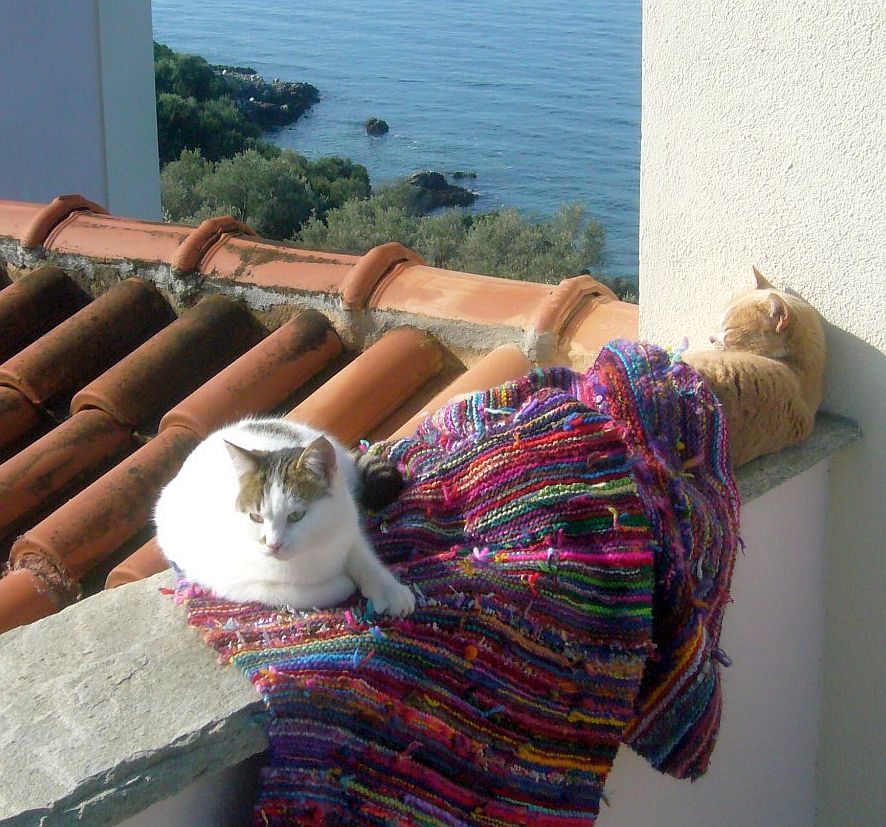
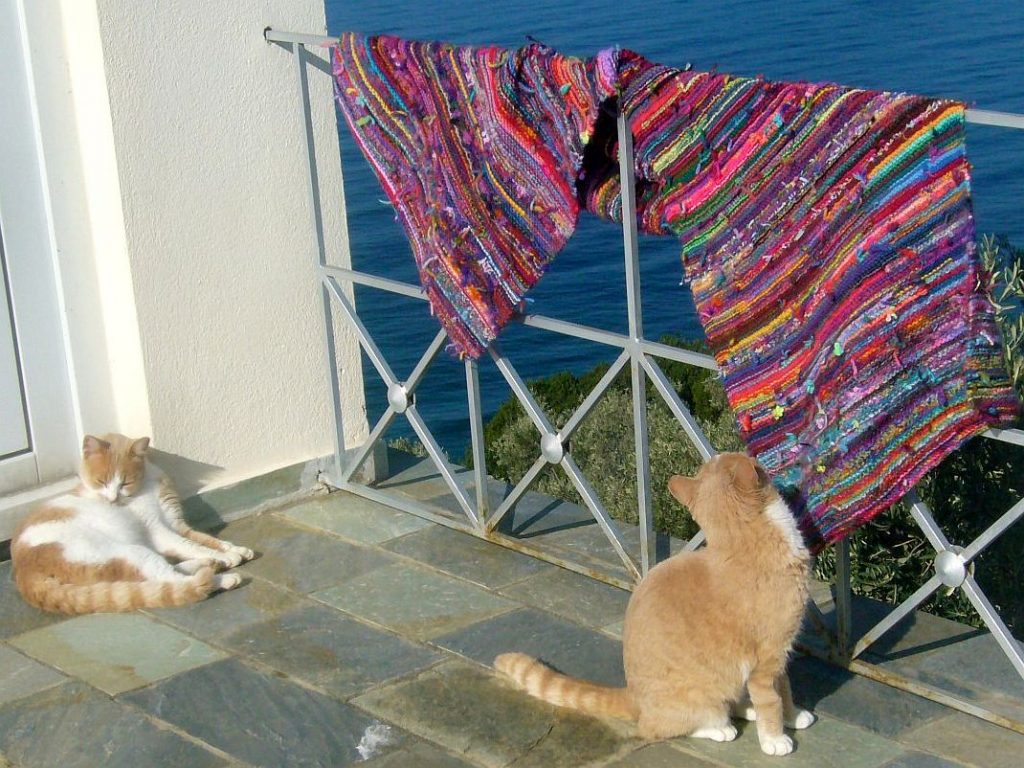
Thanks to my friend Dawn Cusick who provided me the photo of the Happy Blanket I made for her; shown on her balcony in North Carolina.

![P1270068 [HDTV (1080)]](http://chasingcentaurs.com/wp-content/uploads/2015/06/P1270068-HDTV-1080-1024x768.jpg)
![P1270357 [HDTV (1080)]](http://chasingcentaurs.com/wp-content/uploads/2015/06/P1270357-HDTV-1080-1024x629.jpg)
![P1270020 [HDTV (1080)]](http://chasingcentaurs.com/wp-content/uploads/2015/06/P1270020-HDTV-1080-1024x640.jpg)
![P1270282 [HDTV (1080)]](http://chasingcentaurs.com/wp-content/uploads/2015/06/P1270282-HDTV-1080-1024x579.jpg)
![P1270341 [HDTV (1080)]](http://chasingcentaurs.com/wp-content/uploads/2015/06/P1270341-HDTV-1080-1024x511.jpg)
![P1270278 [HDTV (1080)]](http://chasingcentaurs.com/wp-content/uploads/2015/06/P1270278-HDTV-1080-1024x628.jpg)
![P1270249 [HDTV (1080)]](http://chasingcentaurs.com/wp-content/uploads/2015/06/P1270249-HDTV-1080-1024x635.jpg)
![P1270237 [HDTV (1080)]](http://chasingcentaurs.com/wp-content/uploads/2015/06/P1270237-HDTV-1080-1024x638.jpg)
![P1270337 [HDTV (1080)]](http://chasingcentaurs.com/wp-content/uploads/2015/06/P1270337-HDTV-1080-1024x585.jpg)
![P1270258 [HDTV (1080)]](http://chasingcentaurs.com/wp-content/uploads/2015/06/P1270258-HDTV-1080-1024x655.jpg)
![P1270254 [HDTV (1080)]](http://chasingcentaurs.com/wp-content/uploads/2015/06/P1270254-HDTV-1080-1024x657.jpg)
![P1270207 [HDTV (1080)]](http://chasingcentaurs.com/wp-content/uploads/2015/06/P1270207-HDTV-1080-1024x622.jpg)
![P1270206 [HDTV (1080)]](http://chasingcentaurs.com/wp-content/uploads/2015/06/P1270206-HDTV-1080-1024x594.jpg)
![P1270262 [HDTV (1080)]](http://chasingcentaurs.com/wp-content/uploads/2015/06/P1270262-HDTV-1080-1024x578.jpg)
![P1270271 [HDTV (1080)]](http://chasingcentaurs.com/wp-content/uploads/2015/06/P1270271-HDTV-1080-1024x579.jpg)
![P1270011 [HDTV (1080)]](http://chasingcentaurs.com/wp-content/uploads/2015/06/P1270011-HDTV-1080-1024x681.jpg)
![P1270005 [HDTV (1080)]](http://chasingcentaurs.com/wp-content/uploads/2015/06/P1270005-HDTV-1080-1024x638.jpg)
![P1270317 [HDTV (1080)]](http://chasingcentaurs.com/wp-content/uploads/2015/06/P1270317-HDTV-1080-1024x535.jpg)
![P1260531 [HDTV (1080)]](http://chasingcentaurs.com/wp-content/uploads/2015/06/P1260531-HDTV-1080-1024x700.jpg)
![P1270188 [HDTV (1080)]](http://chasingcentaurs.com/wp-content/uploads/2015/06/P1270188-HDTV-1080-1024x584.jpg)
![P1270200 [HDTV (1080)]](http://chasingcentaurs.com/wp-content/uploads/2015/06/P1270200-HDTV-1080-1024x619.jpg)
![HappyNameDay [HDTV (720)]](http://chasingcentaurs.com/wp-content/uploads/2015/06/HappyNameDay-HDTV-720-150x150.jpg)
![IMG_0078 [HDTV (720)]](http://chasingcentaurs.com/wp-content/uploads/2015/06/IMG_0078-HDTV-720.jpg)
![P1220144 [HDTV (1080)]](http://chasingcentaurs.com/wp-content/uploads/2015/06/P1220144-HDTV-1080-1024x616.jpg)
![P1260554 [HDTV (1080)]](http://chasingcentaurs.com/wp-content/uploads/2015/06/P1260554-HDTV-1080-1024x578.jpg)
![P1270024 [HDTV (1080)]](http://chasingcentaurs.com/wp-content/uploads/2015/06/P1270024-HDTV-1080-1024x664.jpg)
![P1270176 [HDTV (1080)]](http://chasingcentaurs.com/wp-content/uploads/2015/06/P1270176-HDTV-1080-1024x655.jpg)
![P1270182 [HDTV (1080)]](http://chasingcentaurs.com/wp-content/uploads/2015/06/P1270182-HDTV-1080-1024x546.jpg)
![P1270186 [HDTV (1080)]](http://chasingcentaurs.com/wp-content/uploads/2015/06/P1270186-HDTV-1080-1024x774.jpg)
![P1270197 [HDTV (1080)]](http://chasingcentaurs.com/wp-content/uploads/2015/06/P1270197-HDTV-1080-1024x592.jpg)
![P1070745 [HDTV (1080)]](http://chasingcentaurs.com/wp-content/uploads/2015/04/P1070745-HDTV-1080-1024x437.jpg)
![P1070741 [HDTV (1080)]](http://chasingcentaurs.com/wp-content/uploads/2015/04/P1070741-HDTV-1080-1024x576.jpg)
![P1070749 [HDTV (1080)]](http://chasingcentaurs.com/wp-content/uploads/2015/04/P1070749-HDTV-1080-1024x445.jpg)
![P1070753 [HDTV (1080)]](http://chasingcentaurs.com/wp-content/uploads/2015/04/P1070753-HDTV-1080-1024x429.jpg)
![P1070771 [HDTV (1080)]](http://chasingcentaurs.com/wp-content/uploads/2015/04/P1070771-HDTV-1080-1024x444.jpg)
![P1070754 [HDTV (1080)]](http://chasingcentaurs.com/wp-content/uploads/2015/04/P1070754-HDTV-1080-1024x508.jpg)
![P1070748 [HDTV (1080)]](http://chasingcentaurs.com/wp-content/uploads/2015/04/P1070748-HDTV-1080-1024x486.jpg)
![P1070786 [HDTV (1080)]](http://chasingcentaurs.com/wp-content/uploads/2015/04/P1070786-HDTV-1080-1024x486.jpg)
![P1070783 [HDTV (1080)]](http://chasingcentaurs.com/wp-content/uploads/2015/04/P1070783-HDTV-1080-1024x665.jpg)
![IMGP0419 [HDTV (1080)] [1024x768]](http://chasingcentaurs.com/wp-content/uploads/2015/02/IMGP0419-HDTV-1080-1024x768.jpg)
![FeltedHat_1 [HDTV (1080)] [1024x768]](http://chasingcentaurs.com/wp-content/uploads/2015/02/FeltedHat_1-HDTV-1080-1024x768-1024x749.jpg)
![IMGP0425 [HDTV (1080)] [1024x768]](http://chasingcentaurs.com/wp-content/uploads/2015/02/IMGP0425-HDTV-1080-1024x768-1024x654.jpg)
![P1240740 [HDTV (1080)] [1024x768]](http://chasingcentaurs.com/wp-content/uploads/2014/11/P1240740-HDTV-1080-1024x768.jpg)
![P1240647 [HDTV (1080)] [1024x768]](http://chasingcentaurs.com/wp-content/uploads/2014/11/P1240647-HDTV-1080-1024x768.jpg)
![P1240652 [HDTV (1080)] [1024x768]](http://chasingcentaurs.com/wp-content/uploads/2014/11/P1240652-HDTV-1080-1024x768.jpg)
![P1240653 [HDTV (1080)] [1024x768]](http://chasingcentaurs.com/wp-content/uploads/2014/11/P1240653-HDTV-1080-1024x768.jpg)
![P1240655 [HDTV (1080)] [1024x768]](http://chasingcentaurs.com/wp-content/uploads/2014/11/P1240655-HDTV-1080-1024x768.jpg)
![P1240663 [HDTV (1080)] [1024x768]](http://chasingcentaurs.com/wp-content/uploads/2014/11/P1240663-HDTV-1080-1024x768.jpg)
![P1240671 [HDTV (1080)] [1024x768]](http://chasingcentaurs.com/wp-content/uploads/2014/11/P1240671-HDTV-1080-1024x768.jpg)
![P1240676 [HDTV (1080)] [1024x768]](http://chasingcentaurs.com/wp-content/uploads/2014/11/P1240676-HDTV-1080-1024x768.jpg)
![P1240747 [HDTV (1080)] [1024x768]](http://chasingcentaurs.com/wp-content/uploads/2014/11/P1240747-HDTV-1080-1024x768.jpg)
![P1240180 [HDTV (1080)] [1024x768]](http://chasingcentaurs.com/wp-content/uploads/2014/11/P1240180-HDTV-1080-1024x768.jpg)
![P1240162 [HDTV (1080)] [1024x768]](http://chasingcentaurs.com/wp-content/uploads/2014/11/P1240162-HDTV-1080-1024x768.jpg)
![P1240146 [HDTV (1080)] [1024x768]](http://chasingcentaurs.com/wp-content/uploads/2014/11/P1240146-HDTV-1080-1024x768.jpg)
![56971_18 [1024x768]](http://chasingcentaurs.com/wp-content/uploads/2014/11/56971_18-1024x768.jpg)
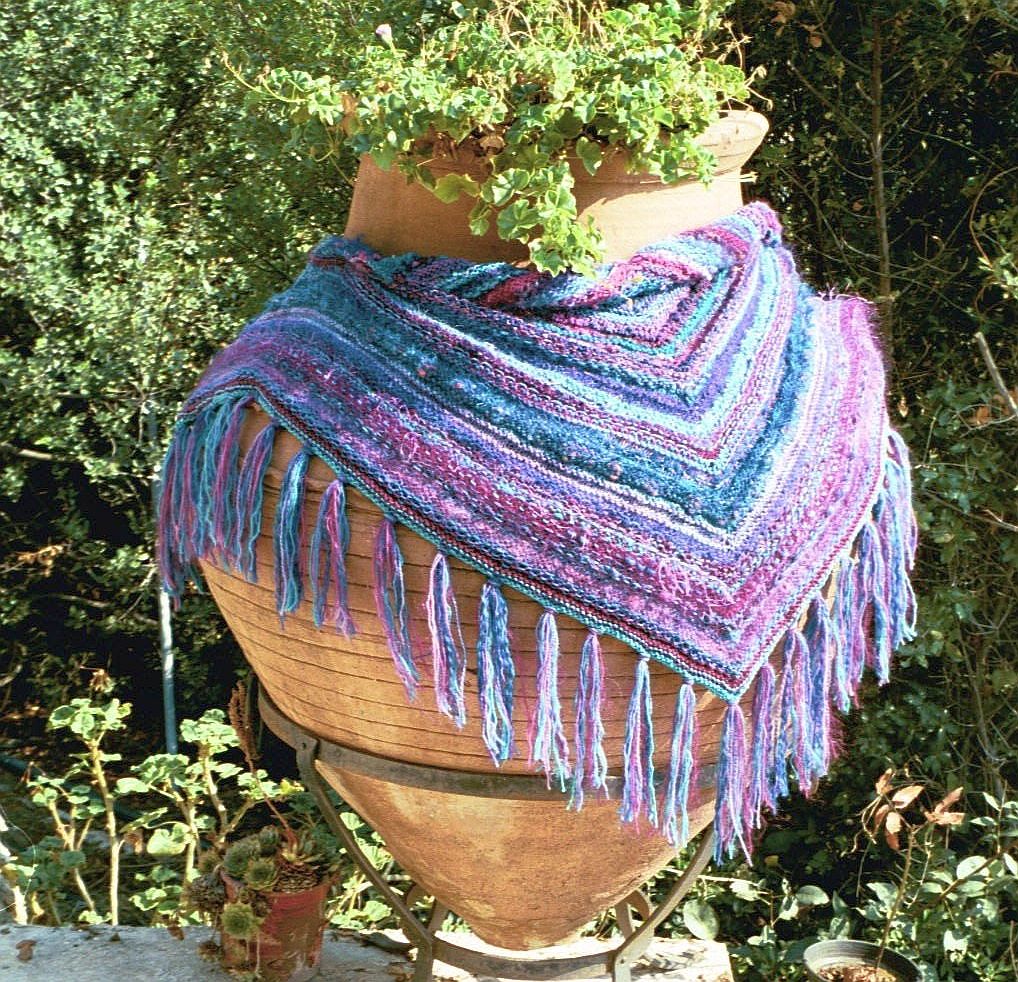
![P1240067 [HDTV (1080)] [1024x768]](http://chasingcentaurs.com/wp-content/uploads/2014/11/P1240067-HDTV-1080-1024x768.jpg)
![P1240097 [HDTV (1080)] [1024x768]](http://chasingcentaurs.com/wp-content/uploads/2014/11/P1240097-HDTV-1080-1024x768.jpg)
![P1240098 [HDTV (1080)] [1024x768]](http://chasingcentaurs.com/wp-content/uploads/2014/11/P1240098-HDTV-1080-1024x768.jpg)
![P1240111 [HDTV (1080)] [1024x768]](http://chasingcentaurs.com/wp-content/uploads/2014/11/P1240111-HDTV-1080-1024x768.jpg)
![P1240092 [HDTV (1080)] [1024x768]](http://chasingcentaurs.com/wp-content/uploads/2014/11/P1240092-HDTV-1080-1024x768.jpg)
![P1240123 [HDTV (1080)] [1024x768]](http://chasingcentaurs.com/wp-content/uploads/2014/11/P1240123-HDTV-1080-1024x768.jpg)
![P1230948 [HDTV (1080)] [1024x768]](http://chasingcentaurs.com/wp-content/uploads/2014/11/P1230948-HDTV-1080-1024x768.jpg)
![Mosaic [1024x768]](http://chasingcentaurs.com/wp-content/uploads/2014/11/Mosaic-1024x768.jpg)
![P1240015 [HDTV (1080)] [1024x768]](http://chasingcentaurs.com/wp-content/uploads/2014/11/P1240015-HDTV-1080-1024x768.jpg)
![P1230975 [HDTV (1080)] [1024x768]](http://chasingcentaurs.com/wp-content/uploads/2014/11/P1230975-HDTV-1080-1024x768.jpg)
![P1230960 [HDTV (1080)] [1024x768]](http://chasingcentaurs.com/wp-content/uploads/2014/11/P1230960-HDTV-1080-1024x768.jpg)
![P1240017 [HDTV (1080)] [1024x768]](http://chasingcentaurs.com/wp-content/uploads/2014/11/P1240017-HDTV-1080-1024x768.jpg)
![P1230967 [HDTV (1080)] [1024x768]](http://chasingcentaurs.com/wp-content/uploads/2014/11/P1230967-HDTV-1080-1024x768.jpg)
![IMGP4264A [1024x768]](http://chasingcentaurs.com/wp-content/uploads/2014/11/IMGP4264A-1024x768.jpg)
![P1230742 [HDTV (1080)]](http://chasingcentaurs.com/wp-content/uploads/2014/10/P1230742-HDTV-1080.jpg)
![IMGP4237 [HDTV (1080)]](http://chasingcentaurs.com/wp-content/uploads/2014/10/IMGP4237-HDTV-1080.jpg)
![IMGP4217 [HDTV (1080)]](http://chasingcentaurs.com/wp-content/uploads/2014/10/IMGP4217-HDTV-1080.jpg)
![IMGP4214 [HDTV (1080)]](http://chasingcentaurs.com/wp-content/uploads/2014/10/IMGP4214-HDTV-1080.jpg)
![P1230821 [HDTV (1080)]](http://chasingcentaurs.com/wp-content/uploads/2014/10/P1230821-HDTV-1080.jpg)